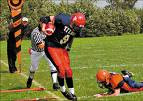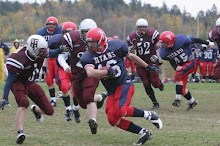As our football camps approach in the next couple of weeks you'll notice that our football fields are becoming busier with players throwing footballs, punters, kickers with father's holding, as well as quarterbacks throwing the football in anticipation of the upcoming football training camp.
One of the things you can do if some of your players are available is to implement a couple of hours per week in implementing a passing skeleton. For the most part, a lot of the players will be kicking around anyway and looking for something to do so why not! It's a good time to get together, throw the football, and practice your offence and defence without the pressure of preparing for a game. Coverage's and routes can be tweaked and players can shuffle in and play both sides of the football all the while receiving coaching and practicing plays and systems that will be used for the upcoming season.
It's also a good way to introduce new players to your passing system, and defensive coverage's while having fun throwing the football. Your skeleton participation is always optional taking in consideration that it is summer and your kids need their down time as well. The main thing is to let them know that your there if they are interested, if not no big deal!
Cheers!
\
Monday, August 9, 2010
Wednesday, August 4, 2010
Football Tackling Drills:Head Position in Tackling
As a youth football coach it's very important that when we are teaching tackling that we make sure that we emphasize that the players never use their head to butt, ram, spear, or make contact with an opponent. In drills covering tackling, all football coaches need to make this a priority.
I read an interesting article the other day whereby a neuro-surgeon with a football back round stated that the best way to teach our youth football players to tackle would be with out helmets. That way they would develop a good tackling technique that would protect and not involve the head.
Now I wouldn't recommend this but I do certainly understand his point.
With the pencil necks that we coach at the youth level the head never should be part of the equation. The point of contact when making a tackle should be the chest with the head back. If you examine any youth shoulder pad the breast plate is well protected and designed to sustain contact. Once contact is made the player should be taught to drive up and through his opponent with his arms, latch, keep his feet moving, and take his opponent to the ground.
Tackling drills should cover straight on tackling and angle tackling with the coach emphasizing point of contact and proper head position. Players should be taught to never, ever drop their heads, and with their head back at all times, watch and follow the hit in all the way. One of the things I have incorporated in tackling drills is that in the early sessions of teaching tackling is to tackle with "thud" contact, head back, wrap up, and do not leave your feet. Now "thud" contact is controlled half speed contact whereby we want the contact to be initiated but, the emphasis is on good tackling technique with head back, and proper form and technique. We stick with controlled "thud" contact until we are comfortable that all players have good tackling fundamentals and then we will pick up the speed a little more in the contact drills.
And you know what happens?
Once the speed is picked up a little, a lot of young tacklers will drop their heads on contact. At this point as a coach you have to step in, review technique once again, and send them back to "thud" school for more training. A couple of trips through "thud school" will get them thinking. What's most important is that they never tackle at a faster speed until they pass "thud school". Then it's controlled progression in all tackling drills until they have it right.
Cheers!
I read an interesting article the other day whereby a neuro-surgeon with a football back round stated that the best way to teach our youth football players to tackle would be with out helmets. That way they would develop a good tackling technique that would protect and not involve the head.
Now I wouldn't recommend this but I do certainly understand his point.
With the pencil necks that we coach at the youth level the head never should be part of the equation. The point of contact when making a tackle should be the chest with the head back. If you examine any youth shoulder pad the breast plate is well protected and designed to sustain contact. Once contact is made the player should be taught to drive up and through his opponent with his arms, latch, keep his feet moving, and take his opponent to the ground.
Tackling drills should cover straight on tackling and angle tackling with the coach emphasizing point of contact and proper head position. Players should be taught to never, ever drop their heads, and with their head back at all times, watch and follow the hit in all the way. One of the things I have incorporated in tackling drills is that in the early sessions of teaching tackling is to tackle with "thud" contact, head back, wrap up, and do not leave your feet. Now "thud" contact is controlled half speed contact whereby we want the contact to be initiated but, the emphasis is on good tackling technique with head back, and proper form and technique. We stick with controlled "thud" contact until we are comfortable that all players have good tackling fundamentals and then we will pick up the speed a little more in the contact drills.
And you know what happens?
Once the speed is picked up a little, a lot of young tacklers will drop their heads on contact. At this point as a coach you have to step in, review technique once again, and send them back to "thud" school for more training. A couple of trips through "thud school" will get them thinking. What's most important is that they never tackle at a faster speed until they pass "thud school". Then it's controlled progression in all tackling drills until they have it right.
Cheers!
Subscribe to:
Posts (Atom)














